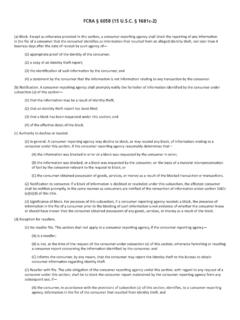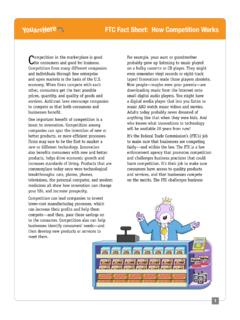Transcription of Consumer Price Index: First Quarter 2011
1 Consumer Price Index: First Quarter 2011. bureau of labor statistics May 2011 Volume 2, Number 3. Current Price Topics among detailed items as relative prices Differences between the change. In practice, superlative indexes are Consumer Price Index and difficult to implement in real time because the Personal Consumption such indexes require expenditure data for the Expenditures Price Index period that is current, and such data are not available. For example, data on household In the United States, there are two primary Consumer expenditures that are used to measures of the prices paid by consumers estimate the CPI are not available for the for goods and services. One is the Consumer current period. For the Consumer Price Index Price Index (CPI), which is produced by the for Urban Consumers (CPI-U), a Laspeyres bureau of labor statistics (BLS); the other index provides an alternative to the Fisher- is the Personal Consumption Expenditures Ideal (PCE) Price index, prepared by the bureau of To estimate a formula effect, or the Economic Analysis (BEA).
2 These two indexes differences in the rates of growth between are constructed differently and tend to the CPI and PCE caused by the differences behave differently over time. For example, in formula, the detailed Price and quantity in the fourth Quarter of 2010, the CPI rose at data used to estimate the PCE index can be a annualized rate, while the PCE. reaggregated with the use of a Laspeyres Price index rose at a annualized Price -index formula. rate, a difference of percentage Weight effect. The relative weights assigned Categorizing the Differences to each of the CPI and PCE categories of The differences between the CPI and PCE items are based on different data sources. measures of inflation can be summarized The relative weights used in the CPI are based into four categories or effects.
3 The following primarily on the Consumer Expenditure sections quantify the magnitude of these Survey, a household survey conducted for effects over two distinct periods. the BLS by the Census bureau . The relative weights used in the PCE index are derived Formula effect. The CPI and the PCE index from business surveys for example, the are constructed from different index-number Census bureau 's annual and monthly retail formulas. The CPI index is an average based trade surveys, the Service Annual Survey, and on a Laspeyres formula, whereas the PCE. the Quarterly Services Survey. index is based on a Fisher-Ideal formula. A. Fisher-Ideal index is considered a superlative In order to estimate a weight effect, or the index in that it reflects Consumer substitution effect of using different weight sources on CPI.
4 1. C U R R E N T P R I C E T O P I C S. and PCE index changes, CPI relative weights Medicare and Medicaid. These differences can for comparable item categories can be used also be isolated and measured, and can be to estimate the PCE fixed-weight Price index. referred to as scope effects.. Scope effects. The CPI measures the change Other effects. A variety of remaining in the out-of-pocket expenditures of all urban differences consisting of seasonal-adjustment households and the PCE index measures the differences, Price differences, and residual change in goods and services consumed by all differences must be taken into account for a households, and nonprofit institutions serving complete understanding of the differences households. This conceptual difference means between the CPI and the PCE index.
5 For that some items and expenditures in the PCE example, the PCE index for airline fares index are outside the scope of the CPI. For is based on passenger revenues and the example, the expenditure weights for medical number of miles traveled by passengers. The care services in the CPI are derived only from CPI, however, is based on prices charged for out-of-pocket expenses paid for by consumers. air travel for sampled routes. By contrast, medical care services in the PCE. index include those services purchased out Reconciliation of pocket by consumers and those services Using this methodology, McCully, Moyer, and paid for on behalf of consumers for example, Stewart3 reconciled the CPI and the PCE Price medical care services paid for by employers index for 2002 through the First half of 2007.
6 A. through employer-provided health insurance, summary of their reconciliation, as well as an as well as medical care services paid for by updated reconciliation for the fourth Quarter governments through programs such as of 2010, is presented in table 1. Table 1. Summary of differences between the CPI and PCE Price index for the First Quarter of 2002 through the second Quarter of 2007 and for the fourth Quarter of 2010. 2002 through First half Fourth Quarter , Effect and Price change of 2007 2010. PCE chain-type Price index (average annual percent change) Plus formula effect (percentage points) Equals PCE fixed-weight Price index (average annual percent change) Plus weight effect (percentage points) Plus scope effect (percentage points) Plus other effects (percentage points) Equals CPI (average annual percent change) Source: More detailed, updated monthly and quarterly reconciliations of the CPI and the PCE Price index appear each month in table at #S9 (visited April 26, 2011).
7 2. C U R R E N T P R I C E T O P I C S. During both periods shown in table 1, the CPI is significantly higher in the PCE index. This rose more than the published PCE chain-type difference in the concept of medical care index. As expected, the formula effect was services accounted for a large portion of the positive, reflecting differences between the 2002 07 scope effect, as medical care costs Fisher-Ideal formula used in the PCE chain- outpaced overall inflation during that period. type Price index and the Laspeyres fixed- The scope effect in the fourth Quarter of 2010. weight Price index used in the CPI. ( percentage point), however, was much smaller than in 2002 07, because medical care In the earlier (2002 07) reconciliation, the inflation in late 2010 was more modest. majority of the weight effect was due to shelter costs.
8 Shelter has a significantly higher Finally, other effects during 2002 07 were relative weight in the CPI than the PCE, and negligible. In the fourth Quarter of 2010, shelter inflation generally outpaced overall the effect was caused inflation from 2002 2007. With lower shelter primarily by differences between BLS and inflation in 2010, the impact of different BEA in the treatment for estimating, and the shelter weights between the CPI and the timing for revising, seasonally adjusted data. PCE Price index has fallen. Instead, increases in gasoline prices, coupled with the larger As the preceding discussion shows, the CPI. relative weight for gasoline in the CPI, and the PCE chain-type Price index provide contributed most to the weight effect in the a measure of the change in prices paid by fourth Quarter of 2010.
9 Consumers for goods and services. Differences in formulas, weights, scope, and other The scope effect in 2002 07 was a negative methods can cause the two indexes to behave percentage point, meaning that it was a differently over time. category which had the effect of increasing the PCE index faster than the CPI. Again, Current Price Trends the effect in 2002 07 was due primarily Inflation in the First Quarter to how changes in medical care costs are of 2011 Was Caused measured in the CPI and PCE. For the CPI, Primarily by Higher Food medical care expenditures include only those and Gasoline Prices directly purchased by consumers. For the PCE index, medical care costs include those All Items purchased directly by consumers as well as The all-items Consumer Price Index for All those paid for on behalf of consumers ( , Urban Consumers (CPI-U) rose at a through employer-provided health insurance seasonally adjusted annual rate during the and through Medicare and Medicaid).
10 In First Quarter of 2011. (See chart 1.) This rise effect, the relative weight of medical care follows increases of percent and 3. C U R R E N T P R I C E T R E N D S. Chart 1. CPI-U percent changes: all items, food, energy, and all items less food and energy for 2010, and First Quarter 2011. SOURCE: bureau of labor statistics percent in the third and fourth quarters of The rise in the energy index in the First Quarter 2010, respectively. of 2011 was led by increases in gasoline and fuel oil. Gasoline prices were up at an The all-items index was up percent, from annualized percent in the First Quarter , March 2010 to March 2011. In 2010, this index while the fuel oil index more than doubled increased percent. on an annualized basis. Electricity and natural gas prices increased and percent, Energy respectively, in the First Quarter of 2011.
















